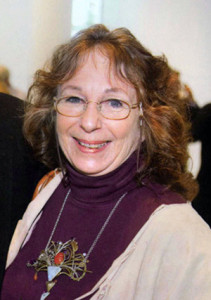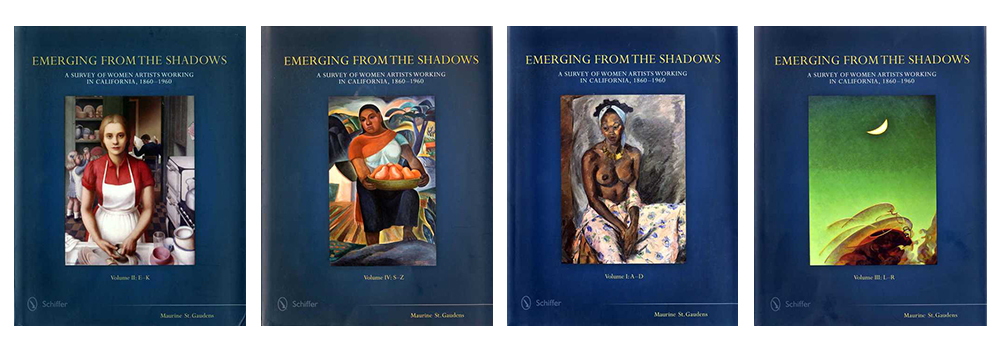
Maurine St Gaudens’ childhood was steeped in art and creativity. As the granddaughter of San Francisco jeweler Maurice Saint-Gaudens, and the third-cousin of noted sculptor Augustus Saint-Gaudens, Maurine’s calling to art took her in the direction of fine arts conservation. She established the Maurine St Gaudens Studio in Pasadena, Calif., and in union with her career as an art conservator, she has been a guest curator for many art exhibitions in Southern California. A subject close to her heart, her four-volume set, Emerging from the Shadows: A Survey of Women Artists Working in California, 1860–1960, was recently published by Schiffer Publishing, Ltd, documenting the 100-year history of 320 women artists. The books contain more than 2,000 color images and trace artworks across styles, movements and media.
What was the inspiration to write this series?
In brief, the project that resulted in the book Emerging from the Shadows: A Survey of Women Artists Working in California, 1860–1960, is something I had considered doing for a number of years. It came about primarily as a result of the work I encountered through my fine arts conservation business, although it began in earnest a little over seven years ago
Many of these women have been forgotten over time, but all were trailblazers in their day. How did you decide who to feature?
One of the questions I am frequently asked during a conservation consultation with a client is, “Who is the artist?” Many times work will come into my studio with the owner knowing very little of the identity of the artist who created it. I make every attempt to provide them with an answer and what I discovered early on was that often there was little if any reference material to help me answer their question. Even though a high percentage of the work I encountered had been created by men, a fact which should come as no surprise, it was the number of really accomplished artworks I was shown, which turned out to have been created by women artists, that truly intrigued me. What I quickly learned was that with a much higher frequency, the women artists seemed to be far less recognized than their male counterparts.
What were the mechanics of your research process?
Frequently, in researching the women artists, no biographical reference existed in the various artist directories or in any of the online artist databases, or if they were listed it was usually with minimal information and almost never was there an example or image of their work or their signature. These were strong, competent and talented women who for whatever reason had been ignored for their accomplishments — I felt it was time for them to be recognized as artists and to emerge from obscurity.
To actually see examples of the artists’ work along with a signature example was for me essential in making these women real. In assembling the book itself, I drew primarily on the art work that had been brought to me — these were the pieces that were found in individual collections, either as works held by art collectors or as pieces directly from the artist’ families. I believe that the works one finds in individual collections is a true barometer of the work of countless working artists.
The idea of presenting visuals — meaning examples of the individual artist’s work and, specifically, an example of the artist’s signature — was a novel idea; how they actually signed their work is incredibly important in identifying an artist and these factors became the focus of the book. In assembling the pieces to be presented, we attempted to show a cross section of each artist’s oeuvre and because so few had accurate biographies, we scoured every conceivable source to assemble a biography for each of the 320 artists included in the book — presenting biographical data is what establishes the artist’s identity.
Of the artists you and your collaborator Joseph Morsman researched, who do you most admire or find most interesting. Why?
We became so enamored with each of the women we profiled in Emerging from the Shadows — to us, each one presented a new discovery either in regard to their life experience or their work itself. I don’t like to suggest my favorites. I am leaving that decision up to each and every individual who views the work.
The fearlessness of so many of these women was certainly a revelation. When you consider what it took to travel from California in the latter part of the Nineteenth Century, to travel to New Your City or to Europe to study must have been an enormous undertaking — but they did it. And the majority of the artists traveled frequently, creating artworks along the way. Therefore, the works shown in the book are from not only California, but from all areas of the globe. The works presented overall represent a number of artistic movements and styles from Nineteenth Century High Realism to Impressionism, Regionalism and WPA, as well as Modernist abstracts and Abstract Expressionism.
Tell me about how you came up with the title Emerging from the Shadows and what that means to you.
The title was actually suggested to me by a very good friend who was very enthusiastic about the idea and purpose for doing the book and fully understood the significance of presenting these artists. I believe that the title really summarized my intention to shed new light on these women — that these women had been in the shadows far too long and that they were truly emerging many for the first time … hopefully they, along with the many we didn’t include in the book, will continue to do so.
—Andrea Valluzzo





